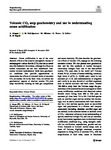Volcanic CO2 seep geochemistry and use in understanding ocean acidification
| dc.contributor.author | Aiuppa, A | |
| dc.contributor.author | Hall-Spencer, Jason | |
| dc.contributor.author | Milazzo, M | |
| dc.contributor.author | Turco, G | |
| dc.contributor.author | Caliro, S | |
| dc.contributor.author | Di Napoli, R | |
| dc.date.accessioned | 2020-12-14T13:57:04Z | |
| dc.date.available | 2020-12-14T13:57:04Z | |
| dc.date.issued | 2020-12-09 | |
| dc.identifier.issn | 0168-2563 | |
| dc.identifier.issn | 1573-515X | |
| dc.identifier.uri | http://hdl.handle.net/10026.1/16742 | |
| dc.description.abstract |
<jats:title>Abstract</jats:title><jats:p>Ocean acidification is one of the most dramatic effects of the massive atmospheric release of anthropogenic carbon dioxide (CO<jats:sub>2</jats:sub>) that has occurred since the Industrial Revolution, although its effects on marine ecosystems are not well understood. Submarine volcanic hydrothermal fields have geochemical conditions that provide opportunities to characterise the effects of elevated levels of seawater CO<jats:sub>2</jats:sub> on marine life in the field. Here, we review the geochemical aspects of shallow marine CO<jats:sub>2</jats:sub>-rich seeps worldwide, focusing on both gas composition and water chemistry. We then describe the geochemical effects of volcanic CO<jats:sub>2</jats:sub> seepage on the overlying seawater column. We also present new geochemical data and the first synthesis of marine biological community changes from one of the best-studied marine CO<jats:sub>2</jats:sub> seep sites in the world (off Vulcano Island, Sicily). In areas of intense bubbling, extremely high levels of pCO<jats:sub>2</jats:sub> (> 10,000 μatm) result in low seawater pH (< 6) and undersaturation of aragonite and calcite in an area devoid of calcified organisms such as shelled molluscs and hard corals. Around 100–400 m away from the Vulcano seeps the geochemistry of the seawater becomes analogous to future ocean acidification conditions with dissolved carbon dioxide levels falling from 900 to 420 μatm as seawater pH rises from 7.6 to 8.0. Calcified species such as coralline algae and sea urchins fare increasingly well as sessile communities shift from domination by a few resilient species (such as uncalcified algae and polychaetes) to a diverse and complex community (including abundant calcified algae and sea urchins) as the seawater returns to ambient levels of CO<jats:sub>2</jats:sub>. Laboratory advances in our understanding of species sensitivity to high CO<jats:sub>2</jats:sub> and low pH seawater, reveal how marine organisms react to simulated ocean acidification conditions (e.g., using energetic trade-offs for calcification, reproduction, growth and survival). Research at volcanic marine seeps, such as those off Vulcano, highlight consistent ecosystem responses to rising levels of seawater CO<jats:sub>2</jats:sub>, with the simplification of food webs, losses in functional diversity and reduced provisioning of goods and services for humans.</jats:p> | |
| dc.format.extent | 93-115 | |
| dc.language | en | |
| dc.language.iso | en | |
| dc.publisher | Springer Science and Business Media LLC | |
| dc.subject | Calcifying species | |
| dc.subject | Ecosystem effects | |
| dc.subject | Natural analogues | |
| dc.subject | Submarine hydrothermalism | |
| dc.title | Volcanic CO2 seep geochemistry and use in understanding ocean acidification | |
| dc.type | journal-article | |
| dc.type | Journal Article | |
| plymouth.author-url | https://www.webofscience.com/api/gateway?GWVersion=2&SrcApp=PARTNER_APP&SrcAuth=LinksAMR&KeyUT=WOS:000597725500001&DestLinkType=FullRecord&DestApp=ALL_WOS&UsrCustomerID=11bb513d99f797142bcfeffcc58ea008 | |
| plymouth.issue | 1 | |
| plymouth.volume | 152 | |
| plymouth.publication-status | Published | |
| plymouth.journal | Biogeochemistry | |
| dc.identifier.doi | 10.1007/s10533-020-00737-9 | |
| plymouth.organisational-group | /Plymouth | |
| plymouth.organisational-group | /Plymouth/Faculty of Science and Engineering | |
| plymouth.organisational-group | /Plymouth/Faculty of Science and Engineering/School of Biological and Marine Sciences | |
| plymouth.organisational-group | /Plymouth/PRIMaRE Publications | |
| plymouth.organisational-group | /Plymouth/REF 2021 Researchers by UoA | |
| plymouth.organisational-group | /Plymouth/REF 2021 Researchers by UoA/UoA07 Earth Systems and Environmental Sciences | |
| plymouth.organisational-group | /Plymouth/Research Groups | |
| plymouth.organisational-group | /Plymouth/Research Groups/Marine Institute | |
| plymouth.organisational-group | /Plymouth/Users by role | |
| plymouth.organisational-group | /Plymouth/Users by role/Academics | |
| dcterms.dateAccepted | 2020-11-24 | |
| dc.rights.embargodate | 2020-12-17 | |
| dc.identifier.eissn | 1573-515X | |
| dc.rights.embargoperiod | Not known | |
| rioxxterms.versionofrecord | 10.1007/s10533-020-00737-9 | |
| rioxxterms.licenseref.uri | http://www.rioxx.net/licenses/all-rights-reserved | |
| rioxxterms.licenseref.startdate | 2020-12-09 | |
| rioxxterms.type | Journal Article/Review |


